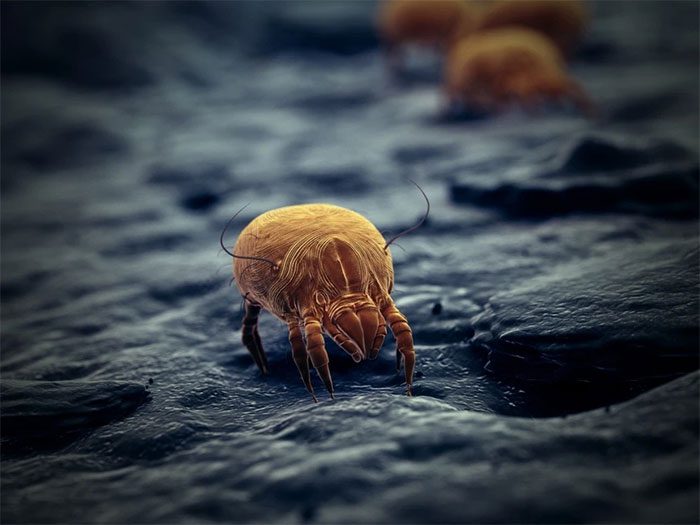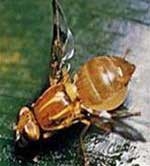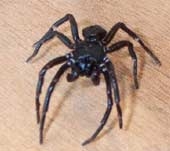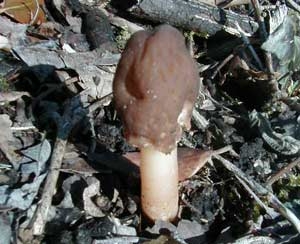The humid and warm climate is an ideal environment for dust mites to live and thrive. As a result, the prevalence of sensitivity and allergies to dust mites in Vietnam is very high.
There is increasing evidence that common allergens include dust mites, cockroaches, grass pollen, mold, pets, and rodents among patients with allergic asthma.
A study conducted at the Allergy and Clinical Immunology Clinic at Ho Chi Minh City University of Medicine and Pharmacy by Dr. Pham Le Duy, a lecturer at the university, and his colleagues shows that over 95% of patients examined are sensitive to at least one type of dust mite.

Dust mites cause allergies in asthmatic patients. (Photo: Alchetron).
Allergic symptoms in children with asthma, adults with dust mite-sensitive asthma, individuals with poor lung function, and abnormal bronchial responses correlate with the levels of indoor dust mite allergens.
The Human Epidermis as Food for Dust Mites
Dust mites measure about 0.3-0.4 mm, making them difficult to see with the naked eye. Dust mites use moisture in the environment as a water source and human and pet epidermis as food and can coexist with various molds.
Therefore, dust mites typically inhabit areas frequented by humans or pets. When we lie on beds, pillows, or sit on sofas, the moisture from our bodies serves as a water source, and the skin flakes shed from our bodies provide food for dust mites.
Additionally, paper and wood can also serve as food sources for dust mites, making them common in places with many old books, decaying wood, and other damp areas in the home.
Dust mites can cause issues such as allergic rhinitis, asthma, difficult-to-control eczema, and in rare cases, anaphylaxis.
Allergy symptoms to dust mites are diverse, with the most common manifestations being those of allergic rhinitis and conjunctivitis (sneezing, runny nose, itchy nose, nasal congestion, itchy eyes, red eyes), asthma (shortness of breath, chest tightness, coughing, wheezing).

The amount of dust mites in dust can range from 10 to thousands of micrograms per gram of dust. (Photo: Shutterstock).
Thus, when experiencing symptoms suggestive of allergies, particularly respiratory allergies as described above, it is important to consult allergy and immunology specialists for examination and testing for airborne allergens that may cause sensitivity, including dust mites.
Cities with Higher Dust Mite Levels
Studies in Vietnam by Associate Professor Dr. Hoang Thi Lam conducted in Hanoi, Professor Dr. Duong Quy Sy conducted in Lam Dong, and Dr. Pham Le Duy conducted in Ho Chi Minh City, reveal that three common types of dust mites across all three regions are: Dermatophagoides pteronyssinus, Dermatophagoides farinae, and Blomia tropicalis.
An individual may be sensitive or allergic to one, two, or all three of the above types, with D. pteronyssinus and D. farinae being the most common.
The concentration of dust mites in dust can range from 10 to thousands of micrograms per gram of dust. The quantity of dust mites may vary depending on the area, as well as between rooms in the same house, with rural areas having fewer dust mites than cities.
Allergy to dust mites can be associated with difficult-to-control eczema or chronic urticaria. In less common cases, dust mite allergies can also cause anaphylactic reactions and anaphylactic shock, which require timely emergency treatment to prevent a high risk of death.
Therefore, it is essential for the public to prevent exposure to dust mites. Prevention will involve a combination of different methods, as there is no single effective approach.
We should regularly vacuum our homes, air out and shake dust from bedding, pillows, and mattresses; wash and sun-dry fabric items and dust clean to reduce dust mite allergens.
Simultaneously, everyone needs to maintain indoor relative humidity below 60%. Consider using mite-proof covers for pillows and mattresses. Homes should be ventilated daily 1-2 times to improve air circulation.
If there are pets like dogs or cats, they should be bathed and groomed regularly, as dust mites can cling to their fur, and the skin flakes that fall can be a food source for dust mites.





















































